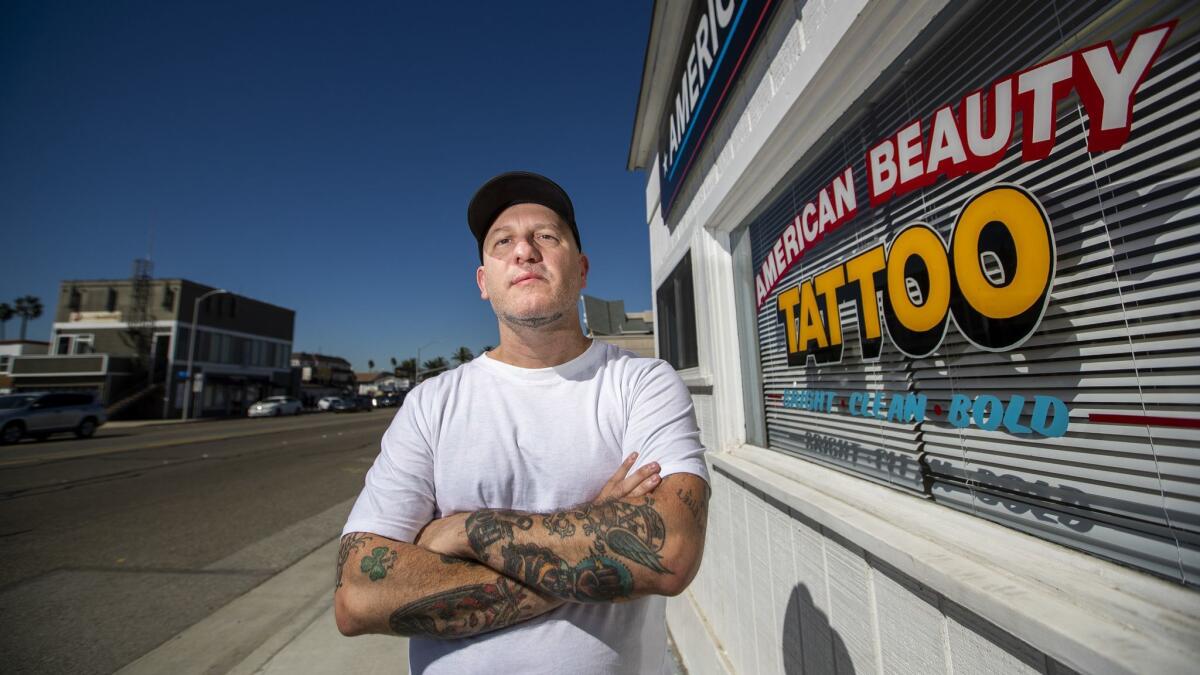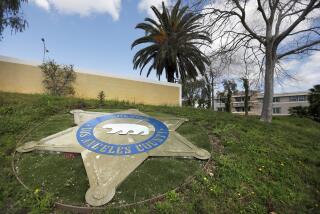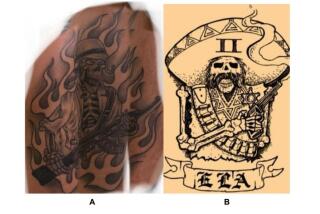L.A. County Sheriff’s Department pays price as clandestine deputy cliques persist

- Share via
The image on the deputy’s calf depicted a skeleton in an officer’s uniform, wearing a cowboy hat and clutching a smoking rifle.
Jason Zabala said he was inked by an artist who worked at a Sunset Beach tattoo shop and was the 140th person to get the same design. The tattoo, he said, was a proud mark of camaraderie among his fellow peace officers.
But years later, a judge would order Zabala and another Los Angeles County sheriff’s deputy to answer questions about whether they were members of a clique and allow their tattoos to be photographed as part of a wrongful-death lawsuit. The county paid $1.5 million to settle the case last year. Zabala denied he was part of a clique.
The Sheriff’s Department is paying a growing price for its failure to find a solution for an issue that decades of watchdog reports and lawsuits have highlighted as a problem.
The tattoos and questions about cliques are being used to challenge deputies’ credibility in court. Officers who are sued over allegations of excessive force have been compelled to answer questions about their ink and allow it to be photographed.
“What goes around comes around,” said Merrick Bobb, who was a civilian monitor of the Sheriff’s Department for 22 years. He said the persistence of deputy cliques demonstrates a failure of management.
“This is bound to remain an issue as long as the deputies continue to do it,” he said.
Few police agencies in the nation have received as much public scrutiny over tattoos and alleged cliques. Similar stories of officer cliques have surfaced in Oakland, New Orleans and the Los Angeles Police Department, but the accounts date back several years and rarely involved exclusive membership.
It remains unclear how pervasive the cliques are. Some deputies defend tattoos as fostering morale, arguing that they don’t signify an outlaw culture. Some have also said they have a free-speech right to wear them.
The Sheriff’s Department, however, has continued to face fresh allegations of misconduct attributed to branded groups. Just this month, three sheriff’s deputies and a sergeant were placed on leave in connection with an off-duty fight that some deputies say was a dispute over membership in the Banditos, an East Los Angeles deputy club.
Watchdog panels in 1992 and 2012 exhorted the Sheriff’s Department to root out gang-like deputy groups. Then-interim Sheriff John Scott said in 2014 he would share the results of an investigation into claims of bullying by the Banditos, yet the probe has remained confidential.
In July, Sheriff Jim McDonnell launched what he said would be a comprehensive study of alleged deputy cliques. The inquiry came after The Times revealed that a Compton station deputy involved in a fatal shooting testified that he and as many as 20 of his colleagues have matching skull tattoos.
On Thursday, a judge presiding over a wrongful-death lawsuit involving Compton station deputies said the department must reveal whether it’s identified all of the deputies at the station who have the identical tattoos. Members of the department’s civilian oversight commission Thursday also expressed frustration they had received little information about McDonnell’s inquiry.
McDonnell said in a statement that his organization has taken “a very strong posture” to hold employees accountable, including recently hiring a second constitutional policing advisor to promote reforms.
“We are continuing to assess any potential issues that may arise related to employee conduct, as well as personal and professional choices that impact our organization. We have the same concerns as all of law enforcement, the military, and the private sector about how to balance the constitutional right of free expression with what may, or may not be, an indicator of something more serious,” he said.
‘An icon of the peace officer’
For years, James Real watched as the lawmen traveled to his Sunset Beach tattoo parlor to be branded with the same design.
The Los Angeles County sheriff’s deputies would come in groups, sometimes socializing over pizza as they watched one of their own go under the needle, said Real, the owner of American Beauty Tattoo. An artist in his shop etched the matching motifs of a skeleton wearing a cowboy hat, adding a number in sequential order to each one — more than 100 in all.
The number on Zabala’s tattoo was 140. The skeleton imprinted on his lower left leg was uniformed with a star-shaped badge, appearing next to a tombstone bearing the logo of the department’s Century station, Zabala said in a 2016 deposition that was reviewed by The Times.
Zabala was deposed as part of a wrongful-death lawsuit filed by the family of Terry Laffitte, who was shot by deputies in the back of the head and the leg as he lay face down in his backyard in 2013.
Prosecutors said Laffitte punched Zabala’s partner and was resisting deputies while holding a revolver when Zabala shot him. The district attorney’s office determined the shooting was lawful.
But Laffitte’s family alleged in court documents that Zabala and the other deputy escalated the encounter by violently dragging Laffitte to the ground after pursuing him for riding a bike without a light. The family’s lawyers claimed in their lawsuit that the deputies were part of a clique.
Zabala said in depositions he was not part of a department gang. He said the tattoo, with its Old West style, honored the Sheriff’s Department’s founding in 1850, and he claimed that skeletons are “an icon of the peace officer.”
“It signifies that all police officers are the same. There’s no race. There’s no gender. There’s no color. There’s no bias. It’s just everyone is the same underneath,” Zabala testified. He said he got the ink two or three months before the shooting of Laffitte.
Zabala is now a gang enforcement deputy at the Carson station. He did not respond to requests for comment.
It’s far from clear whether deputy tattoos or involvement in cliques have any direct role in the outcome of court cases. A Times review found more than $7 million in county payouts over the last decade in lawsuits claiming excessive force by deputies known to have matching tattoos as well as to settle a case alleging harassment by an inked deputy gang. Of that amount, $5.5 million was paid out in the last two years.
Those sums are relatively small compared to the total amount the county spent in Sheriff’s Department litigation payouts over the last 10 years — at least $182 million.
Watchdogs say deputies should be more aware of the legal consequences of having matching tattoos.
“It makes any lawsuit extremely more complicated and increases potential liability for the county,” said Michael Gennaco, who headed the Office of Independent Review, which monitored the Sheriff’s Department, for 13 years.
John Sweeney, the attorney in the wrongful-death lawsuit who elicited the admission by a Compton deputy about his tattoo, said lawyers suing the Sheriff’s Department would be silly not to depose deputies over whether they are inked.
“One hundred percent of the time, I ask that question,” Sweeney said.
Earlier this year, the county agreed to pay $2.5 million tied to a separate wrongful-death case involving Zabala. He was one of several deputies who fired a total of 34 rounds at Johnny Martinez, a schizophrenic man, in 2014. Prosecutors, who found the shooting was justified, said Martinez had swung a knife at officers.
Some deputies have admitted that their tattoos correspond to cliques.
Charles McDaniel said under oath in 2013 that his skull ink belonged to the Regulators associated with the Century station, according to a deposition reviewed by The Times.
He said the tattoo signified an attachment to “friends, social group, camaraderie,” but he denied knowing about any deputy clubs that honored members who broke people’s bones — an allegation lodged against a group of deputies at Men’s Central Jail.
In 2009, McDaniel was a floor sergeant at the county lockup when deputies he supervised were accused of repeatedly beating and shocking an inmate with a stun gun, leaving the man with a fractured leg and extensive injuries.
A civil court jury found McDaniel liable for negligence but blamed other deputies for excessive force and battery in the case. The inmate, Tyler Willis, was awarded $290,000 — with $100,000 of the total ordered to be paid out of former Sheriff Lee Baca’s personal funds.
McDaniel, now a lieutenant in the department’s custody division, did not respond to requests for comment. His lawyers argued as part of the court proceedings that he did not participate in the use of force and was not implicated in wrongdoing merely by being a supervisor.
The only policy in the Sheriff’s Department about tattoos says they should remain covered while deputies are on duty. The department often notes that 1st Amendment concerns may prevent officials from crafting stricter rules barring tattoos.
“It seems to me the government would have an uphill battle banning tattoos,” said Eugene Volokh, a 1st Amendment law professor at UCLA. He said California labor law also prohibits employers from interfering with an employee’s political activities, which covers a broad array of behavior that could include being part of a group.
Gennaco, the former Sheriff’s Department watchdog, said the county’s lawyers have resisted past efforts to institute more restrictive policies.
“It’s very difficult to undo [decades] of culture,” he said.
For years, that culture may have been bolstered by the department’s denials about deputy cliques.
After the Kolts Commission completed a wide-ranging investigation of the Sheriff’s Department and recommended in 1992 that officials conduct an inquiry and severely punish deputies displaying gang-like behavior, the agency dismissed the idea.
“The department is confident there are no racist deputy gangs or cliques within the organization and therefore disagrees that an internal investigation is appropriate,” said Sherman Block, who was then sheriff.
The department was more responsive after the Citizens’ Commission on Jail Violence issued findings about widespread mismanagement in the department in 2012. At the recommendation of the panel and other reform efforts, the department began training new deputies about destructive cliques and rotating jail assignments more regularly in order to prevent clubs from forming.
Some deputies still quietly complain — as the jail violence commission pointed out — that captains and other department leaders know who the clique members are within the agency and allow them to operate.
One deputy, who did not want to be named for fear of retribution, said some of “the ink,” as tattooed officers are called, are hard-chargers who drive up the arrest rates at their stations even if it means violating search-and-seizure laws.
“They belong to a clique, but yet they’re out there trying to put gangs away off the streets. I just find it a little hypocritical, if you ask me,” the deputy said.
Another deputy has openly claimed that the cliques try to enforce unfair rules among their own colleagues.
Guadalupe Lopez accused several male officers at the East Los Angeles station of being part of the Banditos, a group that she said wore tattoos of a skeleton in a sombrero and bullied female deputies into submitting to sexual advances.
She claimed in a lawsuit in 2014 that after she complained about verbal abuse and hazing by her colleagues, she suffered retaliation including having eggs thrown at her car and finding a rat under it.
At least four of the deputies she complained about were suspended for a few days over a range of violations including inappropriate conduct, using derogatory language and hazing. Investigators found that one of the deputies told Lopez, “Girls shouldn’t even be allowed to come into this job force,” and, “We’re going to have to regulate” you, according to an internal affairs report.
Another disciplinary letter found that a different deputy told her, “If you don’t submit to the program, you’re going to have a problem.”
The reports did not mention findings related to the Banditos or having tattoos. The county paid $1.5 million to settle Lopez’s case last year. She is no longer a deputy.
The department has launched administrative investigations into questionable tattoos and cliques whenever the allegations have surfaced, especially if deputies were accused of violating policies, said a statement sent by Capt. Darren Harris of the Sheriff’s Department’s Information Bureau.
At American Beauty Tattoo in Sunset Beach, Real said he was stunned by the number of deputies coming in for ink.
It wasn’t uncommon for military members to have coordinated tattoos, he said, but Real said he felt that the identical ink on deputies was cause for concern.
“It paints a very strong picture of a group of law enforcement agents that are basically unifying themselves in a way that resembles a gang,” he said.
Twitter: @mayalau
More to Read
Sign up for Essential California
The most important California stories and recommendations in your inbox every morning.
You may occasionally receive promotional content from the Los Angeles Times.











